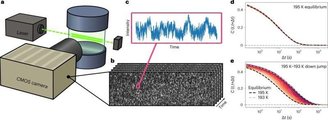According to a study published in the scientific journal Nature Physics, a team of scientists in Germany discovered a fascinating phenomenon while investigating aging processes in different materials. After the analyses; Physicists found evidence of this movement of molecules in glass or plastic can be reversed over time when observed from a certain perspective.
The team of physicists from the Technical University of Darmstadt in Germany and Roskilde University in Denmark found this phenomenon while investigating the aging process in certain materials.
They explain that most laws of physics don’t care about time. Like this, to create tips This contradicts the idea that the aging process is potentially irreversible, at least at the molecular level.
By analyzing some materials at the microscopic level, scientists discovered that: Materials such as glass can undergo reversible aging. Rather than following a path in one direction, the glass particles move and interact with each other, forming different arrangements over time.
“You might think that the aging of materials is as irreversible as the breaking of glass. “But by investigating the motions of molecules in glass or plastic, Darmstadt physicists have discovered that these motions can be reversed over time when observed from a certain perspective.”
Reversible time in glass
By shining a laser at glass during a laboratory experiment, physicists noticed the following: molecules inside the material scattered the light; These scattered beams overlapped and created a chaotic pattern of light and dark spots on the ultrasensitive video camera used to observe the experiment. In this way, they discovered that fluctuations in molecules could be reversed over time..

In any case, it is important to underline that the aging of glass materials cannot be reversed. This is a feature at the molecular level, but it doesn’t mean it can make glass look new after the aging process, scientists say. — so a glass plate cannot ‘break’. In other words, it is a certain time scale that does not contribute to aging.
Till Böhmer, a physicist and one of the study’s authors, explains that this phenomenon is categorized by the concept of ‘material time’, which affects the material at the molecular level but does not change the natural aging process.
“The aging process can be described by what is known as ‘material time’. Picture it this way: The material has an internal clock that works differently than the clock on the laboratory wall. The statement states that the material’s time flows at a different rate depending on how quickly the molecules within the material reorganize.
Always stay informed about the latest discoveries in physics at TecMundo. If you wish, take the opportunity to learn the theory that explains the hidden state change between liquids and solids.
Source: Tec Mundo
I’m Blaine Morgan, an experienced journalist and writer with over 8 years of experience in the tech industry. My expertise lies in writing about technology news and trends, covering everything from cutting-edge gadgets to emerging software developments. I’ve written for several leading publications including Gadget Onus where I am an author.













